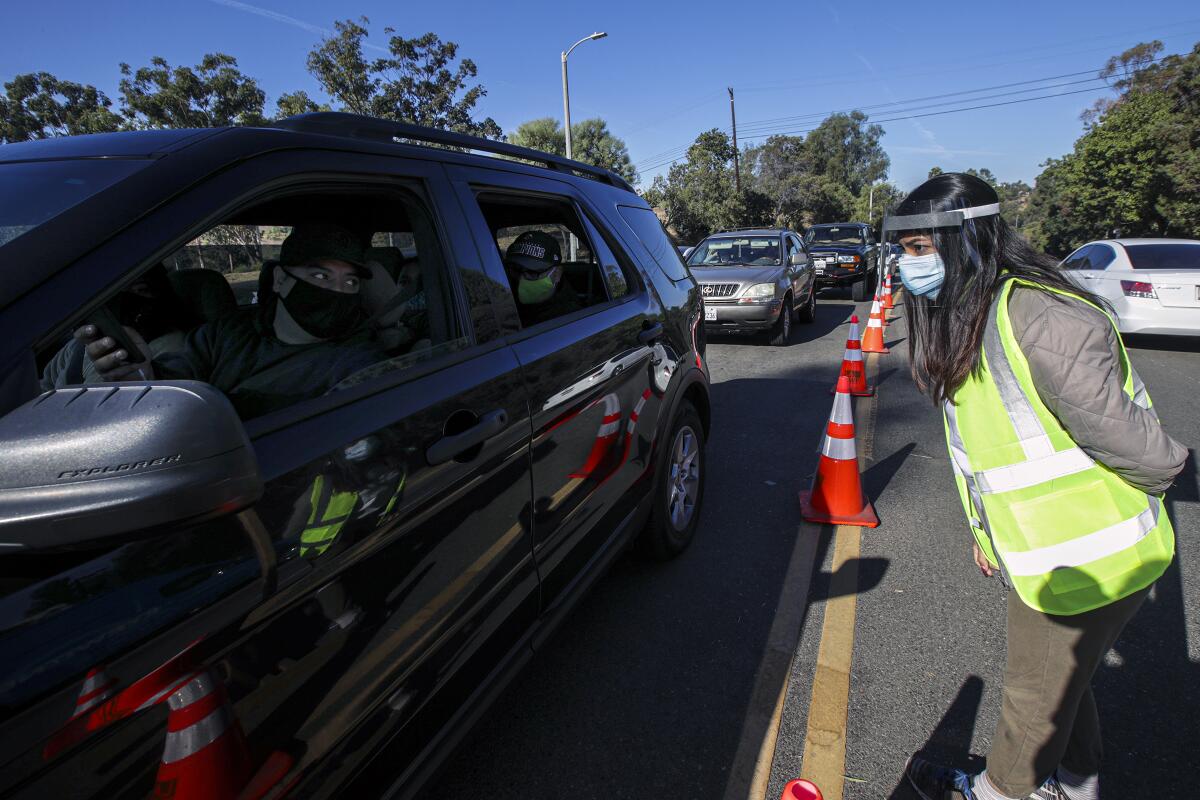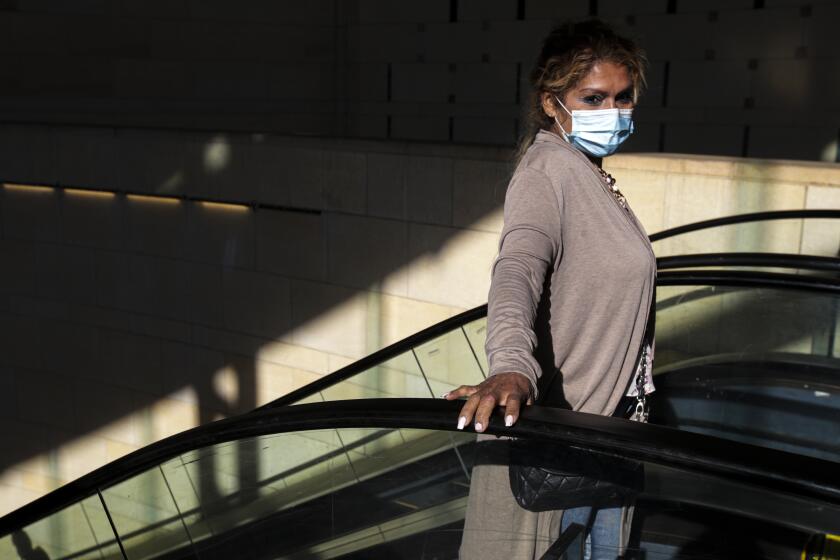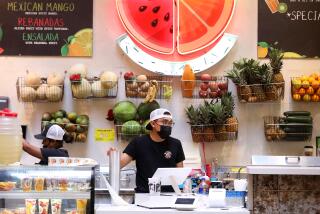California issues travel advisory ahead of holidays as COVID-19 surges

With coronavirus infections continuing to surge in California ahead of Thanksgiving, state officials are urging residents not to travel out of state for the holiday and recommending that those who do quarantine when they return.
Gov. Gavin Newsom issued the travel advisory Friday in conjunction with his counterparts in Oregon and Washington.
“California just surpassed a sobering threshold — 1 million COVID-19 cases — with no signs of the virus slowing down,” Newsom said in a statement. “Increased cases are adding pressure on our hospital systems and threatening the lives of seniors, essential workers and vulnerable Californians. Travel increases the risk of spreading COVID-19, and we must all collectively increase our efforts at this time to keep the virus at bay and save lives.”
However, California Health and Human Services Secretary Dr. Mark Ghaly said Friday that the advisory is just that — “it isn’t a ban; it isn’t a restriction.”
But, he added, “certainly if there’s any indication that the travel advisory needs to be strengthened, we will consider that in the days and weeks to come.”
The state’s advisory encourages residents to stay local and avoid nonessential out-of-state travel. It also asks those who arrive from another state or country to self-quarantine for 14 days.
“We’re encouraging Californians to stay close to home, to avoid nonessential travel to other states, other countries and, frankly, across the state if that’s avoidable,” Ghaly said.
Essential travel, as defined by the advisory, is “for work and study, critical infrastructure support, economic services and supply chains, health, immediate medical care and safety and security,” according to Newsom’s office.
“COVID-19 does not stop at state lines. As hospitals across the West are stretched to capacity, we must take steps to ensure travelers are not bringing this disease home with them,” Oregon Gov. Kate Brown said in a statement. “If you do not need to travel, you shouldn’t. This will be hard, especially with Thanksgiving around the corner. But the best way to keep your family safe is to stay close to home.”
California joined Texas as the first states to confirm 1 million coronavirus cases. The grim milestone comes just before Thanksgiving.
The advisory comes after economic reopenings were rolled back in some parts of the state and it became clear that hard-hit places such as Los Angeles County would not see their restrictions eased for the foreseeable future amid the widespread COVID-19 pandemic.
In L.A. County, officials said this week that more drastic restrictions could be necessary if case rates continue to rise. On Friday afternoon, Health Officer Dr. Sara Cody said Santa Clara County — Northern California’s most populous — would join San Francisco and order the closure of indoor dining. Other counties in the Bay Area are expected to follow suit.
“Every single action that people take is going to help keep people out of the hospital,” Cody said. “It’s going to keep us from needing to order up morgue space. And it’s going to enable our businesses to get back more quickly.”
Call it what you will — a spike, a surge, a wave — but there’s no doubt that coronavirus infections are climbing at an alarming rate in California.
After declining earlier in the fall, California’s weekly cases have doubled in the last month. The Golden State is now averaging about 6,300 new cases a day over the last week, up from about 3,200 a month ago, according to a Times analysis.
The rise has been startlingly steep of late. From Nov. 1 to 7, there was a 47.1% increase in daily case numbers statewide, according to data presented Friday.
Typically, “about 12% of those cases end up in the hospital,” Ghaly said, “and when you look at a high number of cases day over day, and that’s sustained, that’s exactly what we worry about in terms of overwhelming our hospital system.”
COVID-19 hospitalizations have risen 50% in the last month, and the coronavirus positive test rate has climbed by nearly 70%, with 4.4% of test results coming back positive over the last week, up from 2.6% a month ago.
The meteoric ascent has pushed coronavirus infections to unprecedented levels in some parts of the state. San Diego County broke a record this week with its highest single-day number of confirmed cases reported: 661.
In Santa Clara County, new daily coronavirus cases drifted slowly upward in October and then began to skyrocket around election day.
“It’s the steepness of that curve that concerns all of us. And that requires that we act swiftly,” Cody said.
The state as a whole hit 1 million confirmed cases Thursday, another grim milestone in a year full of them. In a sign of the worsening conditions, the drive-through testing site at Dodger Stadium has been flooded with people in recent days.
Gov. Gavin Newsom has announced a stay-at-home order affecting most of California.
If the surge continues in L.A. County, “additional actions” could become necessary to bring the rate of transmission back under control, Public Health Director Barbara Ferrer said Thursday.
Though she didn’t elaborate on what potential new measures could be implemented, Ferrer emphasized that L.A. County remains on a knife’s edge and that everyone needs to do their part to keep conditions from worsening.
“We all need to act now,” she said during a media briefing. “The actions we take today, tomorrow and next week have tremendous impact on the health and well-being of many, many people across the county. If, collectively, we fail to stop the acceleration of new cases, we will have no choice but to look at additional actions.”
In response to a follow-up inquiry from The Times, the Department of Public Health issued a statement Friday saying potential new measures — if necessary — could include “further reducing occupancy at sites that are open, limiting hours of operation at nonessential sectors and restricting higher-risk activities.”
“We would not want to return to stricter safer-at-home orders unless we anticipate a threat to our healthcare system,” the statement continued.
There has been debate about whether California might need to impose further restrictions if COVID-19 continues to spread. That would be bad news for retailers, who have been battered by the shutdowns and were hoping to finally see some relief during the typically busy holiday season.
“And whatever the hell you’re doing, don’t do Black Friday,” said Dr. George Rutherford, an epidemiologist and infectious-diseases expert at UC San Francisco.
Dr. John Swartzberg, an infectious-disease expert at UC Berkeley, said earlier this week that he believes the novel coronavirus is likely to swamp California in December and parts of the state economy will have to be shut down.
“Within a month after Thanksgiving, the number of cases is going to be up significantly,” Swartzberg said. “California is going to be very worried, and we will start to see things close down.”
As cases surge in California, officials are sounding the alarm about travel and gatherings for the upcoming holiday.
Reopening businesses and activities in California is guided by the state’s four-tiered, color-coded system— which it calls the Blueprint for a Safer Economy. The tiers begin with purple, the most restrictive, then shift to red, then orange, then yellow.
Despite the latest surge, Ghaly said the state plans to stick to the current roadmap, which categorizes counties based on their average daily number of new coronavirus cases for every 100,000 residents and the percentage of conducted tests that detect the virus.
Each tier carries its own limitations on what kinds of businesses can reopen, and how widely they can do so.
“It’s a tool not just to loosen but to tighten our restrictions as well,” Ghaly said. “And we believe that it’s helped us so far and that we will continue to count on it now.”
He said there is an “emergency brake” built into the system so the state can more rapidly respond to changing conditions.
For instance, counties typically regress if their metrics fall in the range of a more restrictive tier for two straight weeks. If the numbers merit, Ghaly said it’s possible the state could consider reclassifying them based on one week’s worth of data — or perhaps move them back multiple tiers at once.
However, he said the state is “not looking, today, at a statewide stay-at-home order.”
“All of that said, this is a quickly, rapidly evolving situation, and we will do whatever it takes to make sure that we appropriately protect the public health of California,” he said.
Santa Clara County is in the orange tier but expects to slide back into red next week.
Effective Tuesday, the county will order indoor restaurant dining closed. Capacity at indoor gyms will be reduced from 25% to 10%; outdoor bars will be ordered closed; wineries will be allowed to operate only outdoors; bowling alleys and other indoor family entertainment centers will be shut; and retail businesses will be subject to a 50% capacity restriction, instead of having no limit.
“Acting quickly helps bring things under control faster, and that’s generally true of something where you have an exponential growth curve, like we see with this virus,” County Counsel James Williams said Friday.
AAA says nearly 48 million people are expected to hop into their vehicles for the Turkey Day trek this year. If you’re getting on the road, keep hand sanitizer, gloves and masks fully stocked.
Prior to the state’s travel advisory, L.A. County was recommending that residents don’t travel out of state for the holiday and that if they do, they quarantine for 14 days upon their return.
“If you are going to travel — which we are recommending you not do, we are actually recommending this Thanksgiving be a stay-at-home Thanksgiving — but if you are going to travel, we do ask when you come back that you quarantine for 14 days,” Ferrer said. “And the tighter you can restrict your activities over those 14 days, the better off we all are.”
Though the idea of not seeing family and friends after such a difficult year may strike some as untenable or unreasonable, health officials have repeatedly warned that gathering with those outside one’s immediate household heightens the risk of transmitting the disease.
Ferrer acknowledged it was a sacrifice, saying she won’t get to see her grandchildren for the holiday because they live in another state.
“Like all of you, I wish things were really different. But they’re not,” she said. “And my feeling is I don’t want to be one of the people that’s contributing to not only increasing cases that restrict our ability to continue with our recovery journey, but increasing cases that could result in other people getting sick and even dying.”
California has generally banned large gatherings and says smaller ones of no more than three households may be held outdoors with limitations, including time limits and requirements that attendees physically distance and wear face coverings.
L.A. County, like California as a whole, is seeing a renewed surge in coronavirus infections that shows no signs of dissipating. As of Nov. 3, the average number of daily cases in the county was 1,464 — up from 988 a month prior, Ferrer said.
Recent counts have been even higher. On Thursday, Ferrer reported 2,533 new cases.
The county is also starting to see hospitalizations climb. On Thursday, there were 953 COVID-19 patients in hospitals countywide — up from 777 on Nov. 2, Ferrer said.
Given that it usually takes a few weeks for a crush of cases to result in a corresponding increase in hospitalizations and deaths, Ferrer said that “we most likely haven’t yet seen the full consequence of the surge in cases we recently experienced.”
“While we’ve made impressive strides in caring for people who are ill with the virus, this much of an increase in cases may very well result in tremendous suffering and tragic deaths down the road,” she said.
So far, the county has not seen an uptick in deaths corresponding to the surge. In fact, as of Nov. 2, the average number of deaths per day in the county was 10, which “is the lowest number that we have seen since the very early days of the pandemic,” Ferrer said.
Still, she emphasized, “It’s going to take all of us to avoid increased heartbreak.”
Times staff writer Maura Dolan in San Francisco contributed to this report.
More to Read
Start your day right
Sign up for Essential California for news, features and recommendations from the L.A. Times and beyond in your inbox six days a week.
You may occasionally receive promotional content from the Los Angeles Times.












